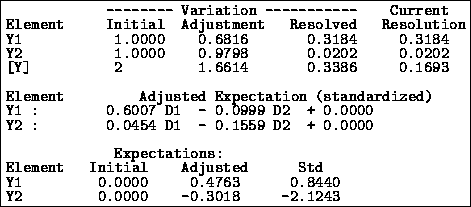As you might guess, once our constructs are defined we can use them
just as though we had defined them from the keyboard. As an example, we
will use them to emphasise some technical properties of the canonical
directions and of the belief structure generated by the canonical
directions. Our name for the particular belief structure
![]() is the belief grid. Let us see what
happens when we adjust the belief grid
is the belief grid. Let us see what
happens when we adjust the belief grid ![]() by
by ![]() , instead of
adjusting the belief structure
, instead of
adjusting the belief structure ![]() by
by ![]() .
.
The following commands define a new collection, or base, ![]() to
contain our belief grid, adjust the collection
to
contain our belief grid, adjust the collection ![]() by the collection
by the collection
![]() , and then display various results of the adjustment:
, and then display various results of the adjustment:
BD>base: Y = Y$ ![]()
BD>keep: -cd ![]()
BD>adjust: [ Y / D ] ![]()
BD>show: v+, e*, a+ ![]()

Figure 22: Adjusting the canonical directions
giving the output shown in figure 22 (with further discussion in section 4.5). What should we notice about this sequence of commands and the output?